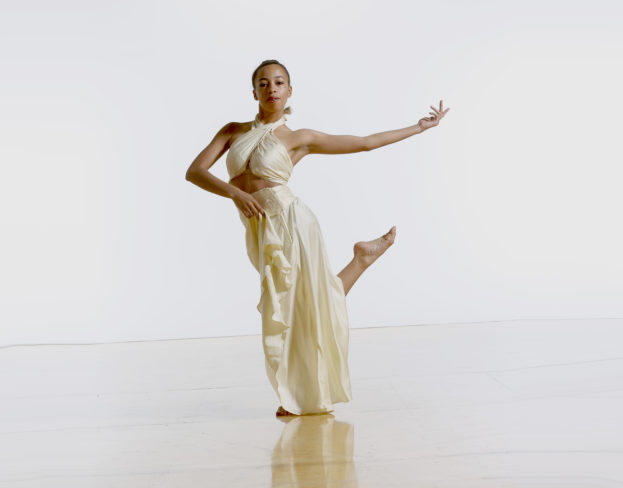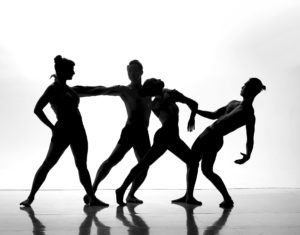
Raissa Simpson is a socially conscious artist that holds community building at the core of her repertoire. Witnesses of her work have seen in-depth studies of topics ranging from Judgment in Milliseconds (2008), a dance about the misperceived perceptions of kinky hair to the Point Shipyard Project (2014) a brilliant work with youth of San Francisco’s Hunters Point neighborhood; it is clear that her work challenges the norm. Her new work, a trilogy entitled Mothership, has been categorized under the term of Afrofuturism. Mothership II, the second installment of the trilogy, will premiere September 22-24 as part of PUSHfest at ODC Theater.
As an artist and long time choreographer for The Kendra Kimbrough Dance Ensemble and co-founder/director of the Black Choreographers Festival, I have frequently been asked the question “What is Black Dance?” This is not a question I like and have yet to see or hear “What is White Dance?” There have been many conversations with fellow choreographers to ponder how does one “correctly” answer this question and why is there the need to consistently ask that question. Choreographers create work that is based in their experiences, that comes from the fiber of their beings. Whether a work has a particular culturally specific theme, it still comes from a cultural place of who “we” are as black people.
Afrofuturism (noun) “is a movement in literature, music, art, etc., featuring futuristic or science fiction themes which incorporate elements of black history and culture.”
This movement is creating nurturing spaces to empower, talk about the grief, the beauty, and the struggle within the communities we are vested in, and to work together through challenges that are specifically calling to our resilience and resistance in America.
As a choreographer and director, Raissa has continued to respond to the call of digging deeper and doing more to create platforms for other socially aware artists that desire an outlet for their work. In 2014 she answered by starting PUSHfest. Within the myriad of ways to describe PUSHfest, in particular for those artists who participate, it is a cross-genre dance festival where artists come together to network and share ideas around dance-making.
I am thrilled to share a recent conversation with Raissa that provides a glimpse into the festival and her work.
Kendra Kimbrough Barnes: What was the motivation behind starting PUSHfest?
Raissa Simpson: During my career as an artist, I underwent a process of collaborating with different dance groups to form home seasons. What I learned is that I present a lot of dance and care deeply about giving artists opportunities to perform. The festival seemed like a natural step to help fulfill my Company’s core values. The other part of my motivation to form PUSHfest was to bridge the gap between emerging and midcareer artists. I find my work being labeled mid-career to be a little nebulous. I’m not exactly young enough to be considered emerging and not old enough to be established.
KKB: Tell me a little bit about Mothership I
RS: Like an intriguing Sci-Fi novel, Mothership is a trilogy of works that challenges cultural traditions and identities through the lens of Afrofuturism—an artistic movement that emerged in the mid-1990s and drew heavily on composer musicians like Sun Ra and Parliament Funkadelic. Afrofuturism re-imagines and reclaims the past, present, and future for Black lives. Afrofuturism often uses the framework of science fiction, speculative history, and Black diasporic mythologies as tools for reinterpreting cultural narratives to open spaces for Black experiences to thrive. My inspirations include Emancipation, Reconstruction, Jim Crow, the Great Migrations and Black Lives Matter, but the undertones of the work question America’s Founding Fathers and the future of Black lives.

KKB: And Mothership II?
RS: The second series is adapted from a 2016 process I started to bring in more intercultural dialogue during the creation period and look at how my multicultural dance interfaces with topics of African American culture. With Mothership II, I grapple with the relationship between cultural identity for marginalized communities of color and the complex contradictions of an American national identity by creating spaces to imagine pasts, presents, and futures for people of color. The audience will see elements of indigenous slave cultures juxtaposed with African astronomy and outer space.
“Mothership” has different meanings. In relation to my work it can mean how African peoples were captured and shipped off to the New World or the distant alien ship come to invade the planet. The underlying question is that if Black people were once considered human or only three-fifths a person, maybe we are actually aliens? Or “mothership” symbolizes all the questions of whether or not Black people will be in space. I’m a sci-fi and Star Trek fan, but the representation for people of color in movies about the future can feel abysmal at times.
KKB: Why is it important to do work around racial identity?
RS: While working with a group of Black mothers this year on a separate project, I found it was almost impossible for us to conceive and discuss the future while we were focused on moments of survival. Whereas I’ve approached my dances in a survivalist form, this new work allows me to imagine marginalized bodies beyond the boundaries of this world. How we persevere is dependent upon having the capacity to use our imaginations.
KKB: Would you categorize your work as Afrofuturism?
RS: Afrofuturism is an essentially optimistic perspective and examining the optimism in my work is a new concept for me. However, any movement including Afrofuturism is a way to make the Africanist aesthetic in my work present. I present my works through the lens of a mixed race woman of African and Asian descent. It’s important for me to acknowledge this background and how it positions me in an ongoing conversation on Afrofuturistic themes and beliefs.
As noted in my inspirations to make the work, I am taking something already done and expanding upon it. Artists as far back as the 1970s like Sun Ra had been exploring these themes, which I think right now it is beginning to be acknowledged. George Clinton’s Parliament Funkadelic released an album called, The Mothership Connection in 1975. A subculture of artists like myself or those working in the AfroPunk movement are all being inspired right now. Is it new? No, but the Afrofuturism that we’re seeing today isn’t the same as the 70s or 90s, it’s something new.

